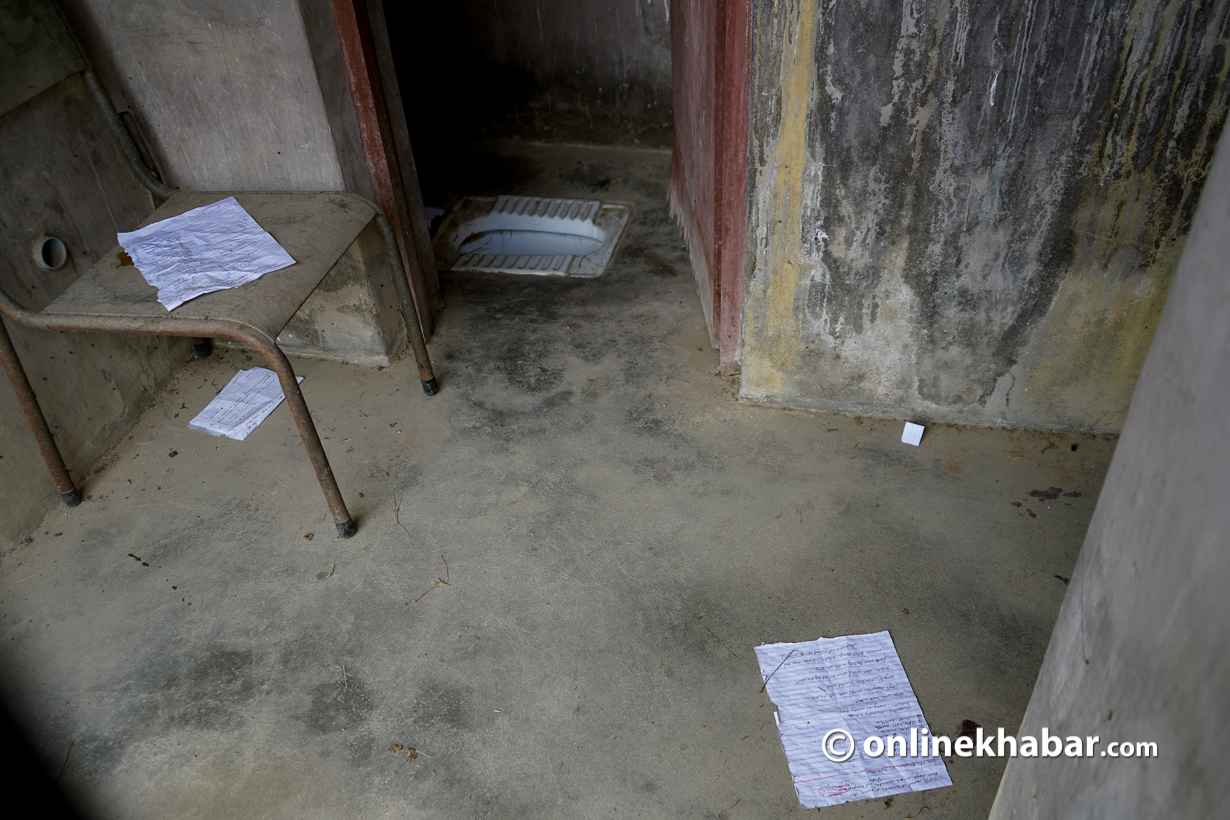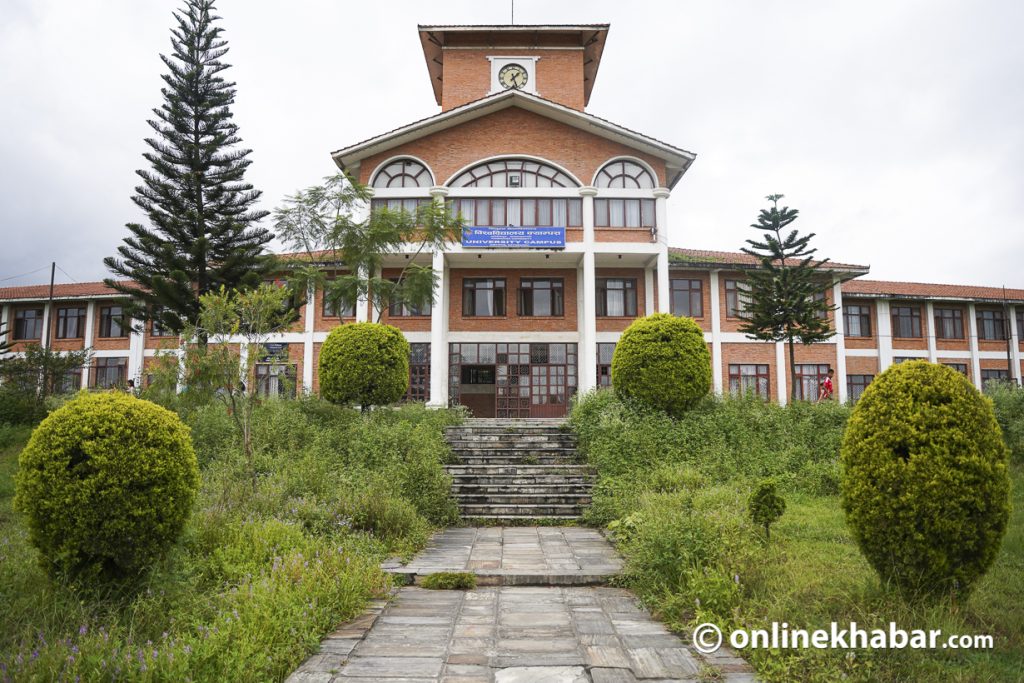Around two weeks ago, despite the widespread demand on social media to cancel the exams, given the impending Covid-19 crisis, thousands of students of the Tribhuvan University reached the university premises to take the exams. But while fighting against one life-threatening problem, there was another issue that the students were struggling through: to get their basic right to urinate in a safe and hygienic manner.
Sujita Sapkota, a third-semester student of the Central Department of Journalism and Mass Communication [Ratna Rajya Laxmi Campus], was one of those students who reached the university’s headquarters in Kirtipur for her exams. “Firstly, it was a hassle to find a toilet there, and when we found one, we entered the boys’ section as there was no clear indication outside. Embarrassed, we found our way to the girls’ section, but the situation was so dire inside that I could not control and vomit.”
Sapkota’s classmate, Sumitra Adhikari, was on her period. As someone who already knew the condition of toilets in the TU, she felt more comfortable as she decided to not choose the toilet altogether. “After three hours of the exam, my pad was drenched and it left bloodstains on my pants and the bench. I left the premises embarrassed, unable to change my pad, as the toilet did not have water to clean and dustbin to dispose of it.”
Male students who reached the TU premises for the exams also confirmed the toilets were unbearable to use. However, they bore the smell and answered nature’s call. They further expressed it is true for public toilets in many spaces like parks, restaurants, hospitals, petrol pumps and even government buildings.
This leaves one question to be answered: when will the students and visitors of the oldest university in Nepal get to pee and poo in peace? Officials answer “soon”, but history says it is unlikely.
The perennial problem
Anisha Bhattarai, a former student of the university, remembers the toilets in the university have been the same for years. “The two years of our college [2014-16] was no less than any physical torture.” Apart from the previously mentioned problems, Bhattarai adds toilet doors and walls would be full of obscene writing that would be embarrassing to read or be in presence of.
Bhattarai and her classmate Kiran Giri, while in the final year of the university, did a small study about the condition of toilets in the university. In 2016, they found two main reasons for this problem. One was from the administration side, the officials’ attitude and lack of resources, monetary and human resources. The second was the attitude of students and their lack of ownership and accountability to clean after themselves.
After passing her masters, Bhattarai was hopeful that the condition of the TU toilets had changed. But, the testaments of the students who reached the TU for the exams recently suggest nothing has changed.
Sanitation expert Prakash Amatya says the toilets, especially in educational institutions, are prone to clogging because the students throw away papers and sanitary napkins there. During exams, the situation gets worse as the toilets are full of “chits” and question papers in every nook and cranny.

“Toilets are the least bit of concern for the officials. That should change.”
According to him, in the reconstruction of schools after the 2015 earthquake, many educational institutions got the aid to construct their buildings, yet they did not prioritise toilets. “When asked, they said they did not get a grant to make the toilets. But, it is not logical because thousands of students and teachers there would need to use the toilets. The response just shows ignorance on their part.”
Initiatives for solutions
Amatya says the ideal toilet-to-user ratio is 1:25 at public places. “But, public toilets we see do not match that criterion. Also, citing that there is no budget or quota, these public toilets are cleaned by one person who has been appointed to clean the whole institution. So, regular cleanup is impossible, though expected, for the cleaner.”
Further, having to clean the toilet and others’ excreta is against the dignity of labour. “The solution is automation,” he stresses.
Meanwhile, realising the problem and its possible solution, students also can take some initiatives.
Pratima Pandey in her fourth year of college took a similar initiative to clean the toilets at the Tri Chandra Campus, Ghantaghar. “Before that, we used to simply endure nature’s call. The state was so dire that students preferred to risk their health, by not going to toilets, rather than using them. It was that repelling.”
As a student of environmental science and a member of the Red Cross, on the occasion of the Toilet Day two years ago, Pandey and a bunch of other students cleaned the campus toilets. However, she had not thought that cleaning toilets would be a political affair. “We took the permission of our then campus chief, but that was not enough. We had to get approval from the student wings of all political parties active there.”

After their initiation, Pandey says, it seems the toilet has become slightly bearable to use, with regular cleanups and unclogged toilets. Leading by example, she says, “After the cleanup, the newer batch of students is looking after it. We hope the change is consistent.”
Necessary reforms
The pathetic situation of the public toilets, says Amatya, can be rectified if there was a guideline in place. But, neither the government nor institutions have guidelines in place so far.
Nonetheless, interestingly, the Kirtipur municipality, where lies the most part of the central campus of the Tribhuvan University, already has a guideline in place since 2019. “The guideline is pretty clear about how public toilets should be and ensures they are structured in a way that they are gender-, women-, child- and disabled-friendly; they are regularly cleaned. It also ensures facilities for those who clean the toilets,” informs Gyan Bazra Maharjan, the head of the Environment and Solid Waste Management Sub-section of the municipality.
However, Maharjan realises the guidelines has not been followed given the gaps in policymaking and implementation. “We have identified 12 public toilets in Kirtipur, three of which were new and were made following the guideline. But, the older ones and ones inside any institution, including the TU, has not been regulated yet.”
Although the local government has plans to launch WASH programmes and construct better toilets inside the TU with the proper water management system according to the guideline, he says, “With the Covid-19 restrictions in place, the plans have been pushed back, yet we will prioritise inter-institution coordination here forward.”
Meanwhile, Maharjan claims the public will soon see the change like they transformed the toilets inside the TU International Cricket Ground, under the said guidelines.
No one knows how soon is soon as claimed by Maharjan. Currently, the toilets at the international cricket ground are unclean and sans the proper water supply. “They cleaned the toilets for the public some three months ago, once. It is disabled-friendly, but there is no water there. The staff toilet is the same,” a staffer says.



























